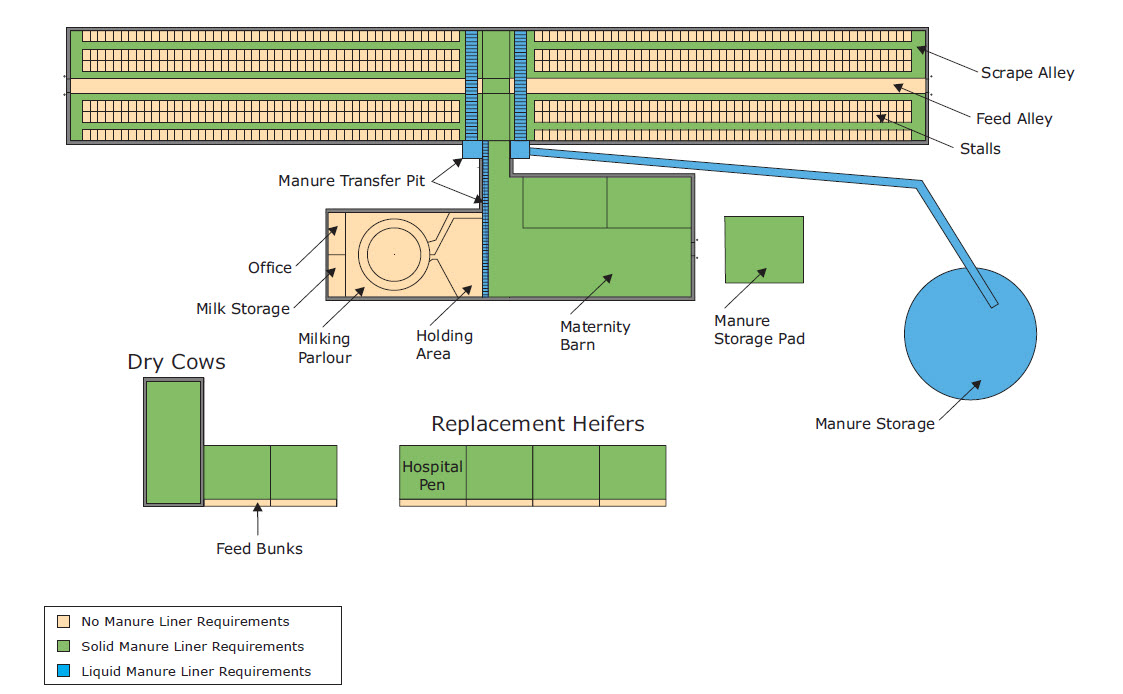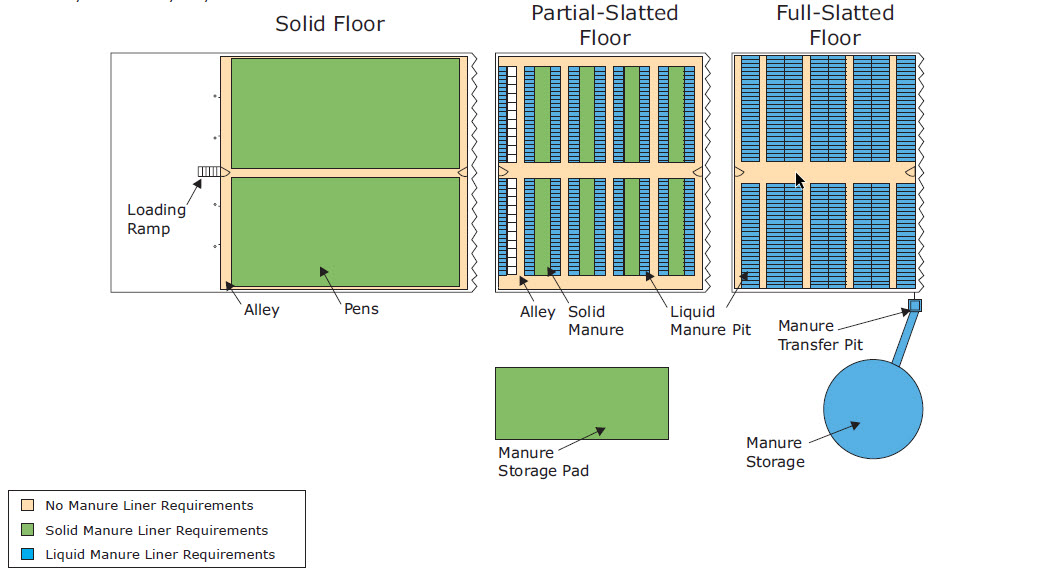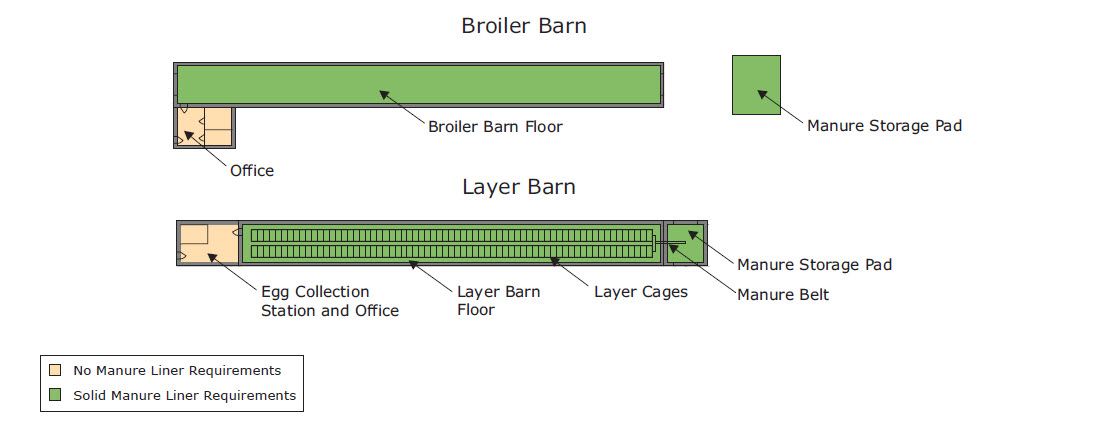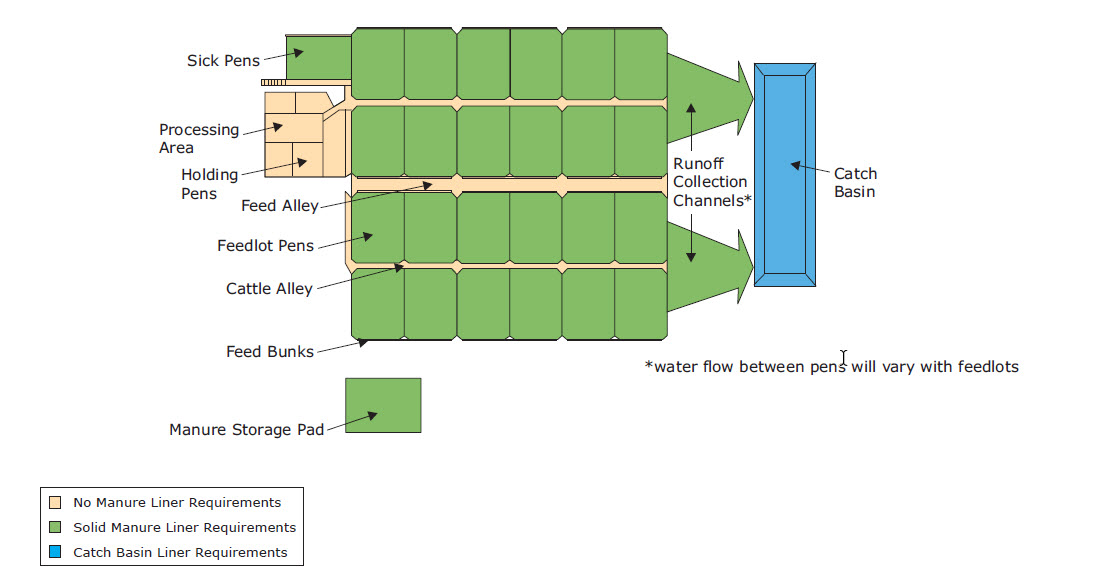| | Purpose
- To identify manure storage facilities and manure collection areas of confined feeding operations so that the groundwater protection requirements of the Agricultural Operation Practices Act can be met
Audience
- Operators, consultants, and contractors designing and constructing CFO facilities
Relevant Legislation
- Agricultural Operation Practices Act and the Standards and Administration Regulation
Related Technical Guidelines
Introduction
The Agricultural Operation Practices Act (AOPA) and associated regulations set requirements to ensure groundwater protection for manure storage facilities (MSF) and manure collection areas (MCA) within a confined feeding operation (CFO). MSF and MCA must have either a protective layer or a constructed liner between the facility and the uppermost groundwater resource below the site. The standards for these layers or liners are based on the type of facility and the type of manure.
CFOs will include areas for manure collection and storage as well as areas for animal housing, handling and specific types of production, such as milk parlours or egg sorting. In order to better understand what part of the CFO needs to meet the regulations this guideline provides information on four types of livestock facilities: dairy, swine, poultry and feedlots.
This guideline provides guidance on determining the specific layer or liner requirements for different manure types within these four facility types. Liquid manure refers to manure in a predominately liquid state, or manure to which water has been added. Solid manure refers to manure that is at least 20% solid matter and does not flow when piled.
This guideline also describes areas within livestock facilities, based on typical facility use and production systems. As there are a variety of production systems that can be utilized, not all livestock facilities are described in this guideline. If the guideline does not describe a particular production system, consult with the Natural Resources Conservation Board (NRCB) to determine how to define areas with a particular livestock
facility.
Dairy
The stalls in a dairy barn are considered to be a non-manure area because manure is not normally deposited in the stall. If manure solids or compost are used as bedding material, operators need to contact the NRCB for clarification. Dairy barns are designed so that manure is deposited by the cattle into the alley from which it is scraped into the manure pit. Any area where the manure is deposited and then moved into the pits is considered a solid manure area (eg. scrape alleys). Both in-barn manure pits and connected outdoor manure storages are considered to be liquid manure areas.
Loose housing facilities such as dry cow barns and replacement heifer pens are often designed to hold solid manure. Milking parlours, feed bunks, holding areas and feed alleys are considered to be non-manure areas.

Figure 1. Dairy Facilities
Swine
Swine facilities can have solid floors, partially-slatted floors or fully-slatted floors. Partially-slatted and slatted floors are located over manure pits. Solid floors, or the solid portion of a partially-slatted floor, are considered solid manure areas. The in-barn pits below partially-slatted and slatted floors and the associated outdoor storage are liquid manure areas.
Walkways and alleyways are non-manure areas.

Figure 2. Swine Facilities
Poultry
Poultry operations, including broiler and layer barns, are considered to be solid manure facilities. The floor of layer barns with cages and belts are considered solid manure areas to allow for conversion to other production systems, such as aviaries or loose housing. Egg collection and office areas are non-manure areas.

Figure 3. Poultry Facilities
Feedlot
Feedlot pens are considered solid manure areas. Sick pens are considered solid manure areas, as they almost always have manure in the pens even though the number of livestock present is usually small or infrequent. A processing barn, or area of chutes and squeezes where cattle are actively being handled, including the associated processing pens is considered to be a non-manure area. Runoff collection channels between the feedlot pens and the catch basin are considered solid manure areas, as they convey runoff rather than catch it.

Figure 4. Feedlot Facilities
For More Information
Contact your nearest NRCB field office or an AF Agri-Environmental Extension Specialist (dial 310-0000 to be connected toll free).
Alberta Agriculture and Forestry
www.agriculture.alberta.ca/aopa
Ag Info Centre 310 FARM (3276)
Publications (780) 427-0391
Natural Resources Conservation Board
www.nrcb.ca
Morinville (780) 939-1212
Red Deer (403) 340-5241
Lethbridge (403) 381-5166
This guideline was developed by the Technical Advisory Group, a partnership between Agriculture and Forestry, the Natural Resources Conservation Board and the agricultural industry.
Source: Agdex 096-94. June 2018. |
|